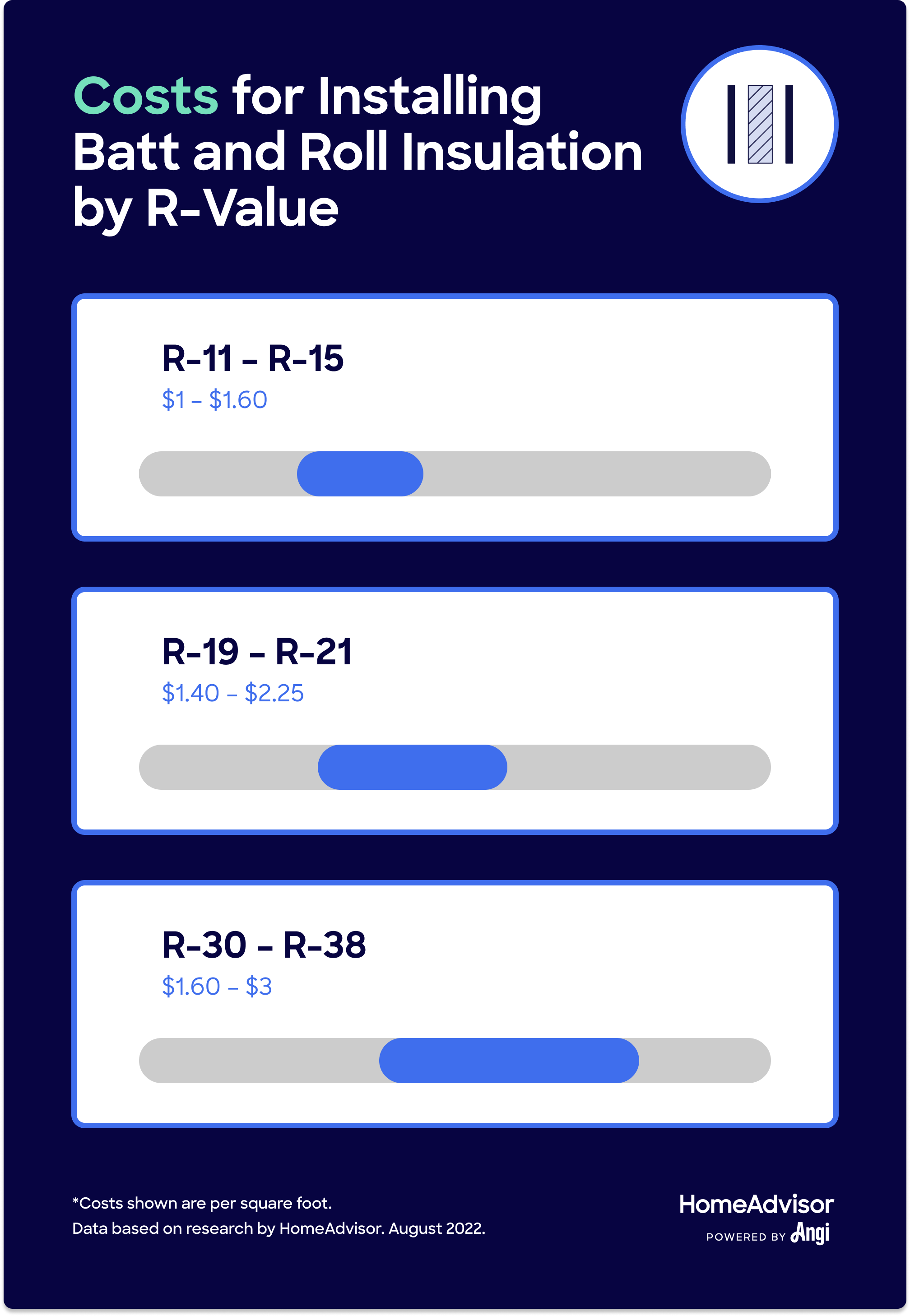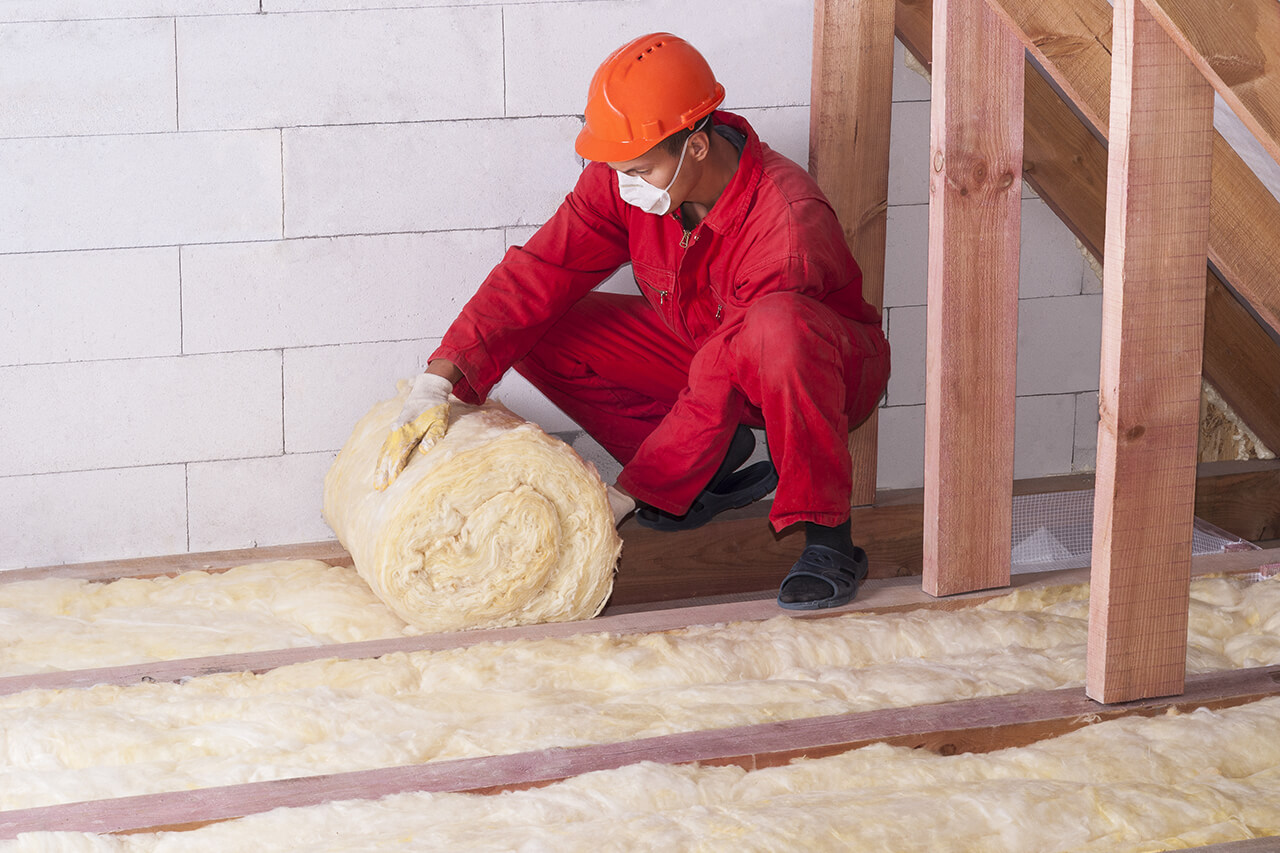How Much Does Batt And Roll Insulation Cost To Install?
Typical Range:
$1,065 - $2,630
Typical Range:
$1,065 - $2,630
Cost data is based on actual project costs as reported by 7,400 HomeAdvisor members. Embed this data
.
.
.
.
.
.
.
.
.
.
.
.
.
.
.
.
.
.
.
.
.
.
.
.
.
.
.
.
.
.
•
•
•
•
Updated September 19, 2022
Written by HomeAdvisor.Batt insulation and roll insulation are essentially the same things, with one cut for length and the other a continuous roll. Batt insulation generally comes in 15- and 23-inch widths and is cut to standard wall heights to fit most cavities in the walls, floors, and ceilings between the framing. On average, batt and roll insulation costs $1,846, or typically between $1,065 and $2,630. However, expect to spend more depending on the R-value, project location, and the installation complexity.
Let's calculate cost data for you. Where are you located?
Where are you located?
| National Average | $1,846 |
| Typical Range | $1,065 - $2,630 |
| Low End - High End | $498 - $4,500 |
Cost data is based on actual project costs as reported by 7,400 HomeAdvisor members.
A standard insulation project costs $1,050 to $2,800 for about 1,000 square feet. You'll spend anywhere from $1 to $3 per square foot for batt or roll insulation, including materials and labor.
| Square Feet | Average Installation Cost |
|---|---|
| 100 | $100 – $300 |
| 300 | $300 – $900 |
| 500 | $500 – $1,500 |
| 700 | $700 – $2,100 |
| 1,000 | $1,000 – $3,000 |
| 1,500 | $1,500 – $4,500 |
| 2,000 | $2,000 – $6,000 |
| 2,500 | $2,500 – $7,500 |
Blanket insulation comes in the form of batts or rolls and consists of flexible fibers, commonly known as fiberglass. Fiberglass is the most common insulation material, is made from long strands of flexible glass fibers, and comes in low-density, medium-, and high-density options. Blanket insulation is also made with wool, plastic, and organic fibers like cotton.
Ecobatt is a sustainable insulation material made from sand and recycled glass, and ecobatt insulation costs about $1 to $2.25 per square foot.
An insulation roll costs about $0.50 to $1.70 per square foot. The price fluctuates depending on the insulation's brand, material, thickness, and R-value.
You’ll spend between $0.45 to $1.80 per square foot depending on the R-value, which measures how long it takes for heat to flow from one side of the insulation to the other. The higher the R-value, the slower the transfer (or loss) of heat. Colder climates generally need higher R-values to maintain temperatures in your home, with higher R-values typically costing more.
The most common R-value for batt and roll insulation is between R-3 and R-4 per inch of thickness. Depending on the thickness of your insulation, the R-value can go up to 60. Batt and roll insulation is also thicker, limiting how much can go into a standard 2-by-4 wall, at no more than R-15. It's becoming more popular to use 2-by-6 framed construction methods specifically to space studs further apart and provide more depth for insulation, allowing up to R-21.
| R-Value | Insulation Thickness in Inches | Average Price Range per Square Foot |
|---|---|---|
| R-11 | 3.5 | $0.45 – $0.60 |
| R-13 – R-15 | 3.5 | $0.60 – $1 |
| R-19 – R-21 | 5.5 – 6.25 | $90 – $1.25 |
| R-30 | 10 – 15 | $1.10 – $1.40 |
| R-38 | 12.5 – 15.5 | $1.55 – $1.80 |
Installing batt insulation or an insulation roll costs $300 to $800 for a complete project. You’ll pay about $0.50 to $1 per square foot for labor or $40 to $80 per hour. Large or complex projects might run $1,500 or more.
You’ll want to consider a few additional cost factors that apply to both roll and batt insulation:
Faced or unfaced: Add $0.10–$0.20 for faced, whichcomes with a paper facing or foil cover that attaches to the wooden studs or joists and acts as a vapor barrier.
Insulation thickness: Most are cut to fill a 3.5 in depth (standard 2-by-4), a 5.5 in depth (standard 2-by-6) stud, or 10 inches for attics.
Installation complexity: You’ll pay more for complex or hard-to-access projects, particularly if you need to remove drywall to access the space.
The difference between a batt and a roll is that a batt is cut to a specific width, height, and depth to fit between wall studs and comes in the most common height of walls for homes. Rolls are one continuous roll that come in various lengths, from 20 to 40 feet, and best suited for floors and attics or walls with custom heights. You can choose either type with or without facing.
Heat loss in a home comes mostly from windows and air gaps, but otherwise, it travels upward through a home’s floors and ceilings. So it’s important to insulate these areas well. Here are a few other places to consider:
Cathedral ceilings
Walls
Crawl spaces
Around ductwork
In basements
Floors above cold spaces
Up to 70% of a home's energy use comes from heating and cooling. Properly installed insulation lowers energy costs and increases comfort. Follow the tips below for the most effective insulation methods:
Determine the quality of any existing insulation.
Attics should have a minimum R-value of 30 (38 or 40+ for northern states).
Walls should have a minimum R-value of 15.
Seal and insulate your air ducts before covering them with insulation. Repairing leaks makes your HVAC more efficient, saving you money.
Batt insulation and insulation rolls cost significantly less than spray foam insulation, but about the same as blown-in. In most homes, you’ll use a combination of two or three different types.
Batt and roll are sized to go between studs spaced 16 or 24 inches on center. Blown-in tends to get used in attics and spaces otherwise inaccessible by any other type. Spray foam, although expensive, insulates better than any other material, seals up all cracks, and adds a structural element to your walls.
Spray foam insulation costs: $1,300–$4,000 total
Blown-in insulation costs: $900–$2,200 total
Rigid foam insulation costs: $0.25–$1 per board foot
Radiant barrier costs: $700–$3,000 on average
Attic insulation costs: $1,700–$2,000
Batt and roll insulation makes for a great DIY project, but you'll want to watch for a few things when installing it:
Don't compress it. Insulation depends on the air space it provides.
Don't allow any air gaps. It only works when the heat has to pass through it, not around it.
Always wear protective gear. Wear long sleeves, gloves, and a respirator or dust mask when installing most types of insulation materials.
You’ll also need some time to get it done right. Don’t rush insulation. If you don’t have the time or want to avoid the hassle, hire a local insulation installer.
In vertical installations, batt insulation works better since it won’t settle. However, you’ll typically want blown-in insulation in places like your attic or a combination of batt and blown-in.
It costs around $250 to $1,500 in batt or roll materials to insulate 1,500 square feet. The amount of insulation for an entire house varies from home to home, depending on the house's structure.
Expect to pay about $400 to $2,500 in materials to insulate 2,500 square feet with 3 1/2 inches of insulation. Different homes require different amounts of insulation, depending on the structure.
Installing R-30 insulation costs around $1,100 to $2,300 for 1,000 square feet, if the space is open and accessible.
A single roll of insulation typically covers around 40 to 75 square feet. However, coverage areas vary depending on the product manufacturer and type of blanket insulation.
You can estimate the amount of insulation needed for your home by using our total square footage calculator and multiplying it by the cost per square foot of insulation for your chosen R-value. Or you can find an insulation contractor to give you an accurate quote.

